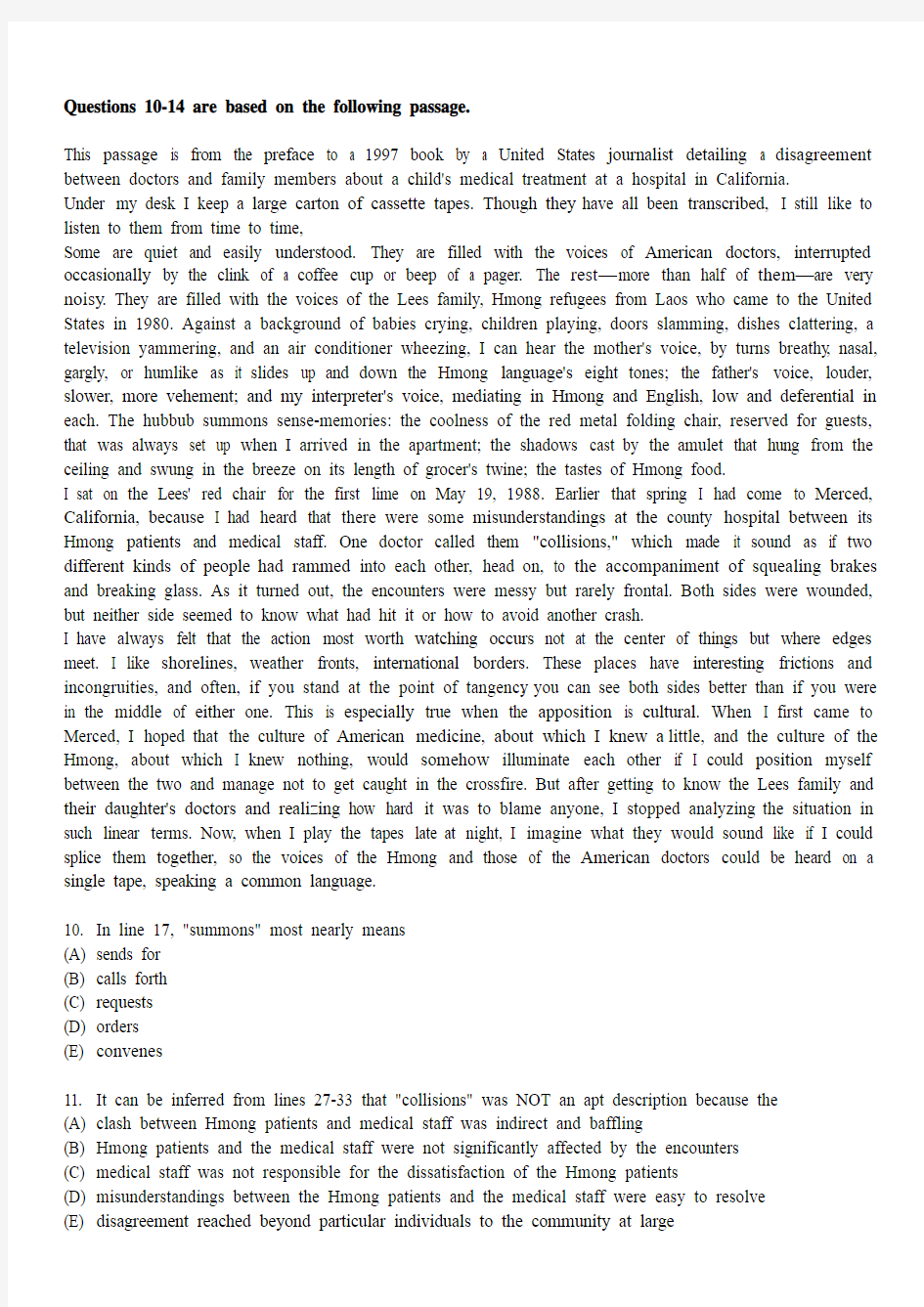SAT阅读测试题1


Questions 10-14 are based on the following passage.
This passage is from the preface to a 1997 book by a United States journalist detailing a disagreement between doctors and family members about a child's medical treatment at a hospital in California.
Under my desk I keep a large carton of cassette tapes. Though they have all been transcribed, I still like to listen to them from time to time,
Some are quiet and easily understood. They are filled with the voices of American doctors, interrupted occasionally by the clink of a coffee cup or beep of a pager. The rest—more than half of them—are very noisy. They are filled with the voices of the Lees family, Hmong refugees from Laos who came to the United States in 1980. Against a background of babies crying, children playing, doors slamming, dishes clattering, a television yammering, and an air conditioner wheezing, I can hear the mother's voice, by turns breathy, nasal, gargly, or humlike as it slides up and down the Hmong language's eight tones; the father's voice, louder, slower, more vehement; and my interpreter's voice, mediating in Hmong and English, low and deferential in each. The hubbub summons sense-memories: the coolness of the red metal folding chair, reserved for guests, that was always set up when I arrived in the apartment; the shadows cast by the amulet that hung from the ceiling and swung in the breeze on its length of grocer's twine; the tastes of Hmong food.
I sat on the Lees' red chair for the first lime on May 19, 1988. Earlier that spring I had come to Merced, California, because I had heard that there were some misunderstandings at the county hospital between its Hmong patients and medical staff. One doctor called them "collisions," which made it sound as if two different kinds of people had rammed into each other, head on, to the accompaniment of squealing brakes and breaking glass. As it turned out, the encounters were messy but rarely frontal. Both sides were wounded, but neither side seemed to know what had hit it or how to avoid another crash.
I have always felt that the action most worth watching occurs not at the center of things but where edges meet. I like shorelines, weather fronts, international borders. These places have interesting frictions and incongruities, and often, if you stand at the point of tangency, you can see both sides better than if you were in the middle of either one. This is especially true when the apposition is cultural. When I first came to Merced, I hoped that the culture of American medicine, about which I knew a little, and the culture of the Hmong, about which I knew nothing, would somehow illuminate each other if I could position myself between the two and manage not to get caught in the crossfire. But after getting to know the Lees family and their daughter's doctors and realizing how hard it was to blame anyone, I stopped analyzing the situation in such linear terms. Now, when I play the tapes late at night, I imagine what they would sound like if I could splice them together, so the voices of the Hmong and those of the American doctors could be heard on a single tape, speaking a common language.
10. In line 17, "summons" most nearly means
(A) sends for
(B) calls forth
(C) requests
(D) orders
(E) convenes
11. It can be inferred from lines 27-33 that "collisions" was NOT an apt description because the
(A) clash between Hmong patients and medical staff was indirect and baffling
(B) Hmong patients and the medical staff were not significantly affected by the encounters
(C) medical staff was not responsible for the dissatisfaction of the Hmong patients
(D) misunderstandings between the Hmong patients and the medical staff were easy to resolve
(E) disagreement reached beyond particular individuals to the community at large
12. Which of the following views of conflict is best supported by lines 37-40 ("These . . . one") ?
(A) Efforts to prevent conflicts are not always successful.
(B) Conflict can occur in many different guises.
(C) In most conflicts, both parties are to blame.
(D)Y ou can understand two parties that have resolved their conflicts better than two parties that are currently in conflict.
(E)Y ou can learn more about two parties in conflict as an observer than as an involved participant.
13. According to lines 41-46 ("When I .. . crossfire"), the author's initial goal was to
(A) consider the perspectives of both the American doctors and the Lees family to see what insights might develop
(B) serve as a counselor to the county hospital's Hmong patients in order to ease their anxieties
(C) work out a compromise between the American doctors and the Lees family
(D) acquire a greater knowledge of how the American medical culture serves patients
(E) try to reduce the misunderstandings between the American doctors and the Lees family and promote good will
14. At the end of the passage, the author suggests that it would be ideal if the
(A) differences between the Lees-family and the American doctors could be resolved quickly
(B) concerns and opinions of the Lees family and the American doctors could be merged
(C) American doctors could take the time to learn more about their Hmong patients
(D) Hmong patients could become more vocal in defense of their rights
(E) Hmong patients could get medical treatment consistent with their cultural beliefs
